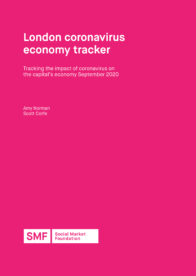This report, commissioned by Peabody, examines the emerging impact of the coronavirus crisis on London’s economy. It explores the latest timely data on economic outcomes to
produce an as up-to-date picture as possible. This is the second in a series of reports which we intend to update over the coming months, as the economic situation continues to develop.
Key findings:
- Between June and August, the unemployment claimant account in London increased by a further 6.5%, greater than the 5.3% seen across the UK as a whole. On this measure of unemployment, this amounts to a further 29,440 individuals out of work in the capital
- By London borough, Croydon and Hackney saw the greatest increases in unemployment between June and August. The claimant count increased by 1,540 in Croydon and 1,385 in Hackney. There are currently three London boroughs – Haringey, Barking and Dagenham, and Brent – where more than one in ten working age residents are claiming unemployment benefits.
- August claimant count data show those in their 30s seeing the greatest increase in unemployment compared with the previous month. In contrast, in July those age 18-24 saw the largest increase. It has been suggested that the unemployment figures for those under the age of 25 are being flattered by young people increasingly seeking shelter in education, choosing to study rather than seek work in a very challenging jobs market.
- Job vacancy numbers in London remain close to 50% lower than they were in the middle of March. In contrast, in the rest of the country, job vacancies have recovered more strongly as lockdown has eased, with the number of job vacancies now about a third (34%) below its mid-March level.
- Analysis of the Labour Force Survey and ONS vacancy data shows that lower income Londoners are disproportionately employed in some of the sectors most affected by declining job availability. For example, 13% of social housing tenants in the capital are employed in wholesale & retail, where job vacancies across the UK over the three months to August were 23% lower than the previous quarter.

Download The Report: PDF
Kindly sponsored by

